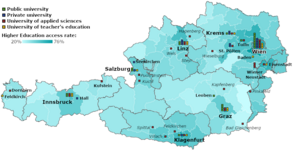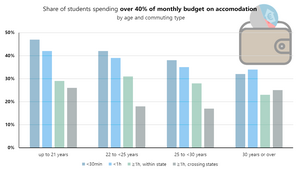Spatial inequalities and the price of a short commute among students in Austria
Authors: Judith Engleder, Robert Jühlke
When debating on social dimension in higher education, very often the focus is on social and cultural differences going along with the family of origin of prospective students. We would like to draw attention to the fact that the familiar background is also entangled with the regional origin, which is neither equally distributed, nor does it provide potential students with equal resources.
Young study aspirants who don’t grow up close to a higher education institution often face a tough choice: Commuting to the nearest institution from the parental home, or moving close to an institution of choice? The former means considerable commuting times and being restricted to choose from a possibly narrow range of study programmes offered there. The latter requires more effort and resources (see also Kaufmann et al. 2004[i]), e.g. to find and afford some sort of housing near the institution.
Regional origin as a dimension of inequality
For this and other reasons, it may be unsurprising that in cities and regions with more academic institutions nearby, a higher share of people takes the path of higher education. Figure 1 illustrates this for Austria: On the level of Austria’s regional districts (Bezirke), the higher education access rate[ii] correlates significantly with the number of universities within the same and neighbouring districts[iii]. However, this correlation vanishes when controlling for the overall share of persons with a higher education degree, which points to the relatively important role of the parental education for higher education choices. Still, we can carry therefrom that regions hosting multiple universities appear to concentrate academic population around it, be it students or graduates.
Conversely, this suggests that other regions are less connected to contexts of higher education, not only socio-demographically but also spatially. The regional origin of (potential) students might have an impact on study and living conditions as well as the selection of a higher education institution and study programme – or, broadly speaking: on educational choices. The closeness to higher education institutions can therefore be viewed as an unequally distributed resource (Kaufmann et al. 2004).
Moving close to a higher education institution: The price of a short commute
When students decide to seek an own place to live, it does not always result in a short commute: In Austria, almost half of students not living with their parents still need at least half an hour (one-way) to reach their institution, for 12% it takes even more than an hour. Besides other individual living criteria, affordability of the accommodation plays a central role when choosing the place of residence. Figure 2 shows that students not living with their parents anymore and living rather close to their higher education institution (which are often situated in city centers, especially universities) more often face an overburden of accommodation costs compared to students in more remote housing options. This is observable in every age group, though younger students are an especially vulnerable group, since their monthly budget tends to be below average and highly dependent on resources of their families[iv].
However, we can also observe that the absolute amount of money spent on accommodation does not necessarily increase the closer students live to their university. Thus, the finding that students with a short commute spend more of their money on accommodation can be attributed to their tighter budgets rather than to higher accommodation expenses.
Summed up, the presented data implies that children of university graduates are more likely to grow up in conurbations and thus near higher education institutions than other children. Furthermore, it can be assumed that the regional origin of potential students has an impact on their educational choices: it requires fewer planning and expenses for some, and more for others to start studying. Combined with the finding that moving out and living (relatively) close to a higher education institution poses more financial risk, a rural origin could be an obstacle to enter higher education, especially for potential first-generation students. To assess these implications further, a holistic view on the transition from school to further education in combination with regional origin should be considered, including regional differences in available educational opportunities and options to commute and/or move.
Article originally published in the EUROSTUDENT blog.
[i]Kaufmann et al. (2004) describe spatial mobility as the ability to reach certain places with more or less effort, depending on individual and structural conditions as well as space itself, and therefore conceptualize it as a form of capital.
[ii] That is the share of persons who grew up in this region attending higher education at some point in life.
[iii] R = 0,464, p < 0,01.
[iv] See Eurostudent VI data on monthly income and family/partner contributions by age.


